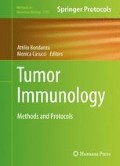Abstract
Hematopoietic stem cell transplantation (HSCT) from an allogeneic donor is an effective form of cancer immunotherapy, especially for acute leukemias. HSCT is however frequently complicated by the occurrence of graft-versus-host disease (GVHD). Immunocompromised mice infused with human T cells often develop a clinical syndrome resembling human GVHD (xenogeneic or X-GVHD). Herein, we describe a method for inducing X-GVHD in a highly reproducible manner. Given the human nature of immune effectors, this xenogeneic model can be routinely adopted for screening the efficacy of new treatments for GVHD.
Access this chapter
Tax calculation will be finalised at checkout
Purchases are for personal use only
References
Mosier DE, Gulizia RJ, Baird SM et al (1988) Transfer of a functional human immune system to mice with severe combined immunodeficiency. Nature 335:256–259
Shultz LD, Schweitzer PA, Christianson SW et al (1995) Multiple defects in innate and adaptive immunologic function in NOD/LtSz-scid mice. J Immunol 154:180–191
Ito M, Hiramatsu H, Kobayashi K et al (2002) NOD/SCID/gamma(c)(null) mouse: an excellent recipient mouse model for engraftment of human cells. Blood 100:3175–3182
Shultz LD, Lyons BL, Burzenski LM et al (2005) Human lymphoid and myeloid cell development in NOD/LtSz-scid IL2R gamma null mice engrafted with mobilized human hemopoietic stem cells. J Immunol 174:6477–6489
King MA, Covassin L, Brehm MA et al (2009) Human peripheral blood leucocyte non-obese diabetic-severe combined immunodeficiency interleukin-2 receptor gamma chain gene mouse model of xenogeneic graft-versus-host-like disease and the role of host major histocompatibility complex. Clin Exp Immunol 157:104–118
Ganguly S, Ross DB, Panoskaltsis-Mortari A et al (2014) Donor CD4+ Foxp3+ regulatory T cells are necessary for post-transplantation cyclophosphamide-mediated protection against GVHD in mice. Blood 124:2131–2141
Stenger EO, Turnquist HR, Mapara MY, Thomson AW (2012) Dendritic cells and regulation of graft-versus-host disease and graft-versus-leukemia activity. Blood 119:5088–5103
Chu CC, Ali N, Karagiannis P et al (2012) Resident CD141 (BDCA3) + dendritic cells in human skin produce IL-10 and induce regulatory T cells that suppress skin inflammation. J Exp Med 209:935–945
Carroll RG, Carpenito C, Shan X et al (2008) Distinct effects of IL-18 on the engraftment and function of human effector CD8 T cells and regulatory T cells. PLoS One 3:e3289
Mutis T, van Rijn RS, Simonetti ER et al (2006) Human regulatory T cells control xenogeneic graft-versus-host disease induced by autologous T cells in RAG2-/-gammac-/- immunodeficient mice. Clin Cancer Res 12:5520–5525
Gregoire-Gauthier J, Durrieu L, Duval A et al (2012) Use of immunoglobulins in the prevention of GvHD in a xenogeneic NOD/SCID/gammac- mouse model. Bone Marrow Transplant 47:439–450
Bondanza A, Valtolina V, Magnani Z et al (2006) Suicide gene therapy of graft-versus-host disease induced by central memory human T lymphocytes. Blood 107:1828–1836
Kaneko S, Mastaglio S, Bondanza A et al (2009) IL-7 and IL-15 allow the generation of suicide gene-modified alloreactive self-renewing central memory human T lymphocytes. Blood 113:1006–1015
Casucci M, Nicolis di Robilant B, Falcone L et al (2013) CD44v6-targeted T cells mediate potent antitumor effects against acute myeloid leukemia and multiple myeloma. Blood 122:3461–3472
Author information
Authors and Affiliations
Corresponding author
Editor information
Editors and Affiliations
Rights and permissions
Copyright information
© 2016 Springer Science+Business Media New York
About this protocol
Cite this protocol
Norelli, M., Camisa, B., Bondanza, A. (2016). Modeling Human Graft-Versus-Host Disease in Immunocompromised Mice. In: Bondanza, A., Casucci, M. (eds) Tumor Immunology. Methods in Molecular Biology, vol 1393. Humana Press, New York, NY. https://doi.org/10.1007/978-1-4939-3338-9_12
Download citation
DOI: https://doi.org/10.1007/978-1-4939-3338-9_12
Published:
Publisher Name: Humana Press, New York, NY
Print ISBN: 978-1-4939-3336-5
Online ISBN: 978-1-4939-3338-9
eBook Packages: Springer Protocols

